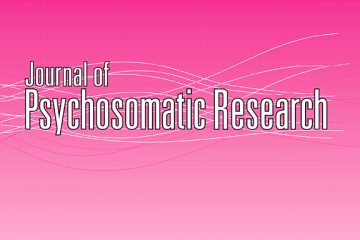JPR: The Editor’s choice
The Editor’s choice March 2018 
Written by Jess Fiedorowicz, Editor of the Journal of Psychosomatic Research
Having assumed the role of Editor-in-Chief on January 1, 2018, I’m delighted to continue the tradition of highlighting an article from the Journal of Psychosomatic Research for the European Association of Psychosomatic Medicine newsletter. These Editor’s Choice articles promote a paper from the past three months that makes an important contribution to our understanding of psychiatric and other medical comorbidity, psychosomatic medicine, or integrated care. For my inaugural Editor’s choice, I will highlight the article, “Pre-treatment anxiety is associated with persistent chemotherapy-induced peripheral neuropathy in women treated with neoadjuvant chemotherapy for breast cancer.”
Taxanes continue to play a central role in the treatment of breast cancer (1). These agents, however, are commonly associated with neuropathy, which can be dose-limiting and may persist for years in up to 30% of patients with an adverse impact on quality of life (2). The mechanisms by which taxanes induce peripheral neuropathy are thought to involve impaired microtubulin structure in long axons (disruption of microtubules is considered the primary mechanism of action for taxanes) or mitochondrial toxicity (2). More advanced age was associated with greater risk of taxane-induced neuropathy in one prospective study (n=50) (3) as well as a larger (N=219) retrospective study that also identified severity of neuropathy symptoms as a risk factors for persistence of neuropathy symptoms (4). A prospective study of mixed chemotherapy treatments failed to identify other clinical or demographic risk factors after adjusting for taxane use, which as expected conveyed elevated risk (5). There had been no study of psychological risk factors for persistent taxane-induced polyneuropathy. There are further no established treatments to prevent or ameliorate this iatrogenic condition.
In our featured article, Kwang-Min Lee of the Seoul National University Hospital and colleagues performed a secondary analysis of a prospective cohort of 111 patients scheduled to receive chemotherapy following surgery for breast cancer (6). Patients were enrolled prior to surgery, which was followed by four cycles of doxorubicin/cyclophosphamide and four cycles of the taxane docetaxel. At the conclusion of the last cycle of chemotherapy, 50 (45%) had symptoms of chemotherapy-induced neuropathy. After an eight month follow-up, 21 (19% of total sample) continued to have persistent neuropathy symptoms. The authors utilized logistic regression to identify risk factors for immediate and persistent neuropathy symptoms. Anxiety symptoms, delineated by a cutoff of ≥8 on the anxiety subscale of the Hospital Anxiety and Depression Scale, was strongly associated (OR 5.01, 95% C.I. 1.84-13.70, p=0.002) with the subsequent development of persistent neuropathy symptoms.
In identifying anxiety as a risk factor for persistent taxane-induced neuropathy symptoms, this study encourages new avenues of research to better understand how persistent symptoms develop and identifies a potential treatment target. These findings also add another layer to a body of literature related to the role of anxiety in pain. The Journal of Psychosomatic Research has been active in disseminating this work with recent publications demonstrating associations between anxiety and chest pain in coronary heart disease (7), chronic pelvic pain (8), vulvodynia (9), multisite musculoskeletal pain (10), and non-specific neck-arm pain (11). Research that helps elucidate the mechanisms by which anxiety influences pain or that develops treatments addressing anxiety in pain are needed. Please consider submitting your best work in this or other relevant areas to the Journal of Psychosomatic Research. I look forward to publishing some of the great work produced by members of the European Association of Psychosomatic Medicine.
Jess G. Fiedorowicz
Editor-in-Chief
Journal of Psychosomatic Research
References
1. Senkus E, Kyriakides S, Ohno S, Penault-Llorca F, Poortmans P, Rutgers E, et al. Primary breast cancer: ESMO Clinical Practice Guidelines for diagnosis, treatment and follow-up. Ann Oncol. 2015;26 Suppl 5:v8-30.
2. Ewertz M, Qvortrup C, Eckhoff L. Chemotherapy-induced peripheral neuropathy in patients treated with taxanes and platinum derivatives. Acta Oncol. 2015;54(5):587-91.
3. Hershman DL, Weimer LH, Wang A, Kranwinkel G, Brafman L, Fuentes D, et al. Association between patient reported outcomes and quantitative sensory tests for measuring long-term neurotoxicity in breast cancer survivors treated with adjuvant paclitaxel chemotherapy. Breast Cancer Res Treat. 2011;125(3):767-74.
4. Tanabe Y, Hashimoto K, Shimizu C, Hirakawa A, Harano K, Yunokawa M, et al. Paclitaxel-induced peripheral neuropathy in patients receiving adjuvant chemotherapy for breast cancer. Int J Clin Oncol. 2013;18(1):132-8.
5. Pereira S, Fontes F, Sonin T, Dias T, Fragoso M, Castro-Lopes JM, et al. Chemotherapy-induced peripheral neuropathy after neoadjuvant or adjuvant treatment of breast cancer: a prospective cohort study. Support Care Cancer. 2016;24(4):1571-81.
6. Lee K-M, Jung D, Hwang H, Son K-L, Kim T-Y, Im S-A, et al. Pre-treatment anxiety is associated with persistent chemotherapy-induced peripheral neuropathy in women treated with neoadjuvant chemotherapy for breast cancer. Journal of Psychosomatic Research. In Press.
7. Palacios J, Khondoker M, Mann A, Tylee A, Hotopf M. Depression and anxiety symptom trajectories in coronary heart disease: Associations with measures of disability and impact on 3-year health care costs. J Psychosom Res. 2018;104:1-8.
8. Brunahl C, Dybowski C, Albrecht R, Riegel B, Hoink J, Fisch M, et al. Mental disorders in patients with chronic pelvic pain syndrome (CPPS). J Psychosom Res. 2017;98:19-26.
9. Chisari C, Chilcot J. The experience of pain severity and pain interference in vulvodynia patients: The role of cognitive-behavioural factors, psychological distress and fatigue. J Psychosom Res. 2017;93:83-9.
10. Auvinen J, Eskola PJ, Ohtonen HR, Paananen M, Jokelainen J, Timonen M, et al. Long-term adolescent multi-site musculoskeletal pain is associated with psychological distress and anxiety. J Psychosom Res. 2017;93:28-32.
11. Ortego G, Villafane JH, Domenech-Garcia V, Berjano P, Bertozzi L, Herrero P. Is there a relationship between psychological stress or anxiety and chronic nonspecific neck-arm pain in adults? A systematic review and meta-analysis. J Psychosom Res. 2016;90:70-81.

0 Comments